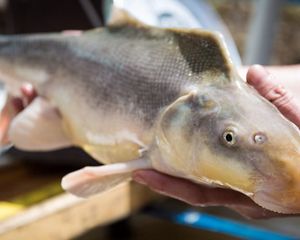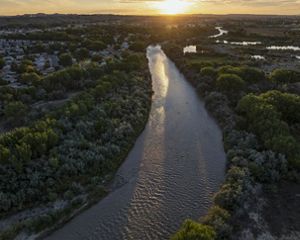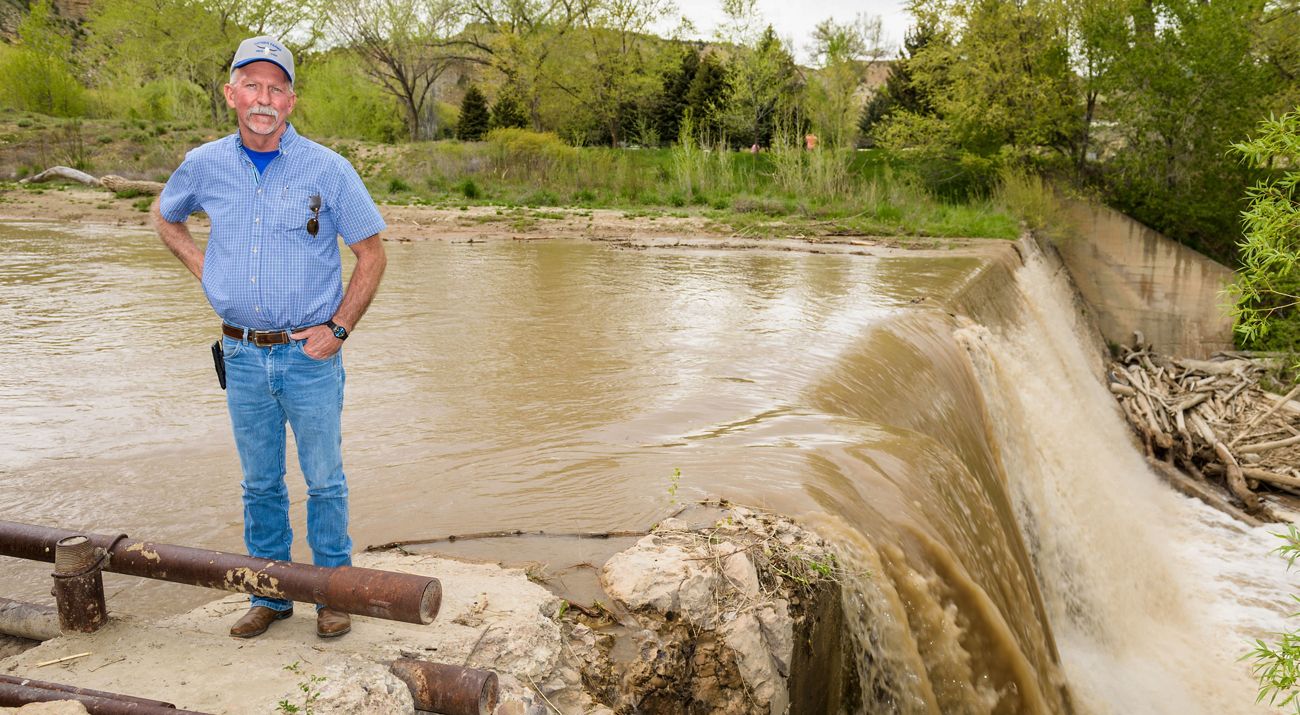
Price River: Solving Problems for Farmers and Fish
An innovative project aims to save and store water, returning it to the river in key seasons, improving habitat for fish and wildlife.
By Larisa Bowen, Senior Writer/Editor, Western US and Canada Division
As it winds toward the town of Price, the Price River flows through Utah’s high desert. In the central part of the state, these remote lands of the Colorado Plateau are rich with the history of past lives. Dinosaurs, Fremont people, Ute tribal members, fur trappers, pioneers, outlaws, immigrants and coal miners have all left remnants of their stories echoing through the sandstone canyons and sagebrush valleys that line the Price.
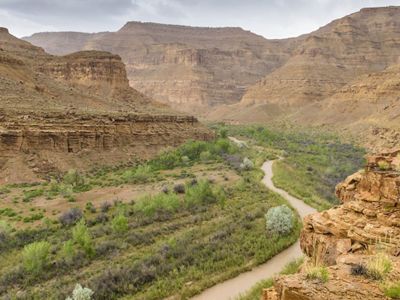
Today, people like farmer and rancher Kevin Cotner are part of a new story unfolding in this region—one that is inexorably tied to the fate of the river itself. Cotner, a straight talker with a wry sense of humor, is the third generation of his family to raise crops in the Price River valley. Over the years, he has seen local attitudes toward the river change. “We get pretty sloppy when water feels abundant,” Cotner notes. “But more people in the ag community are beginning to realize that water is our most precious commodity.” Cotner knows what he’s talking about. In addition to running a farm in America’s second driest state, he’s also the president of the Carbon Canal Company (CCC), which uses the Price River to irrigate 11,000 acres of crops and pastures in Carbon and Emery Counties.
“Going through the small droughts of the last several years brings the issue of water security to the forefront for people,” Cotner says. It’s an issue that’s driven home hard here in the late summer, when the lower Price can see flows drop severely or even run dry in stretches. For alfalfa and hay farmers like Cotner—and for endangered fish like the Colorado pikeminnow—the need to protect this river is increasingly urgent.
That’s why Cotner is excited about CCC’s new collaboration with The Nature Conservancy (TNC) and the Utah Division of Wildlife Resources (UDWR). The innovative project aims to save and store water and return it to the river in key seasons, improving habitat for fish and wildlife, sustaining and protecting farmlands and delivering year-round flows. In the drought-stricken West, this project’s potential for a win-win is turning heads.
Water in the Right Place at the Right Time
“On the Price, we have a unique opportunity because the key river stakeholders are ready to try new solutions,” explains Sue Bellagamba, TNC’s Canyonlands Regional Director. She has been working with Cotner and the CCC to craft this deal, along with a suite of partners including UDWR, the Natural Resources Conservation Service, Jones and DeMille Engineering, the Bureau of Land Management and several local landowners. “What we’ve come up with here,” she says, “is a creative way to get enough water in the right places at the right times.”
How the Project Will Work:
- Capture Carry Water & Release it
The CCC delivers water to irrigated farmland through 27 miles of open canal. A certain amount of carry water is required to push water through the canal and make deliveries for agriculture. This carry water is often unused at the end of the canal system. TNC, UDWR and CCC will now capture the carry water at the end of the canal and store it in Olsen Reservoir, an off-river water body located just south of the town of Price. - Enhance Olsen Reservoir and Increase Wetlands
This project will expand Olsen Reservoir, creating approximately 12 times more water storage capacity. By upgrading the reservoir, the team will restore and increase adjacent wetlands, providing valuable nesting habitat for waterfowl and other marsh birds. For local residents, these improvements will revive the reservoir as a public recreation resource, and downstream farms will enjoy a more secure source of water. - Improve Efficiency of the CCC System
TNC and UDWR will help CCC with canal improvements, such as a new flood control gate and canal piping, to make their system more efficient. TNC will also pay the company a fair market value carriage fee for delivering the carry water to Olsen Reservoir.

We Can’t Save the Price River Without You
Sign up to receive monthly news and stories about our conservation progress. Get a preview of Utah's Nature News email.
Improving Flows
The infographic below shows water movements and benefits of this innovative agreement.
A Win for People & Nature
The payoff of this water agreement between CCC, TNC and UDWR has the potential to be big. Sustainable river flows year-round would be a major improvement for fish and wildlife along roughly 80 miles of the lower Price and would also benefit agricultural lands. For farmers on the CCC canal, the project promises system improvements, including better flood protection and more efficient water delivery.
Cotner also sees the project as an added measure of security for farmers in the face of an increasingly uncertain future. “For me, the big thing is that we’re storing the water. I foresee a time when someone will say we need water in this river, and if we can release those flows downstream, it’ll take pressure off of me and others using this water for agriculture.”
Bellagamba points out that this project will also take pressure off species who are struggling to survive. “The lower Price River provides habitat for six native fish,” she says, “including the endangered Colorado pikeminnow.”
Quote: Sue Bellagamba
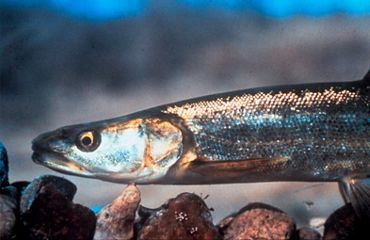
The pikeminnow rely on flows in the spring and summer months which allow them to move up into the lower Price to forage on other fish.
Known as the “canary in the Colorado River Basin,” the Colorado pikeminnow evolved millions of years ago as the largest minnow in North America. Once the top predator in the entire basin, this river goliath used to live as long as 40 years, grow up to six feet in length and reach 80 pounds. But today the pikeminnow rarely lives long enough to get past 80 centimeters. Low water conditions, and dams and obstructions throughout the Colorado River Basin block its migration routes and a glut of non-native fish now compete for its food.
“The pikeminnow rely on flows in the spring and summer months which allow them to move up into the lower Price to forage on other fish,” explains Bellagamba. “We’re hoping that by protecting and maintaining the minimum amount of water this fish needs, our work can play an important role in recovery for this species.”
Part of a Larger—and Urgent—Story
The Price River is located in the Upper Colorado River Basin, flowing 137 miles from the Wasatch Plateau to the Green River. Along its journey it provides water to agricultural lands and towns such as Price and Helper, before joining the Green at Desolation and Gray Canyons in central Utah.
According to Bellagamba: “The story of the Price is tied to the larger story of the Colorado River Basin. We’re talking about one of the most important and most imperiled water systems in the country.”
Criss-crossing seven states and two countries, the Colorado River and its tributaries provide 16 million jobs, generate $1.4 trillion in economic benefits, irrigate nearly six million acres of farmland and supply drinking water to 40 million Americans every year.
People are unquestionably dependent on the health of the Colorado River Basin—and so is nature. In a region that is mostly a desert, these waters are home to 30 native fish species found nowhere else in the world, and they feed habitat that supports a staggering array of the West’s birds and wildlife.
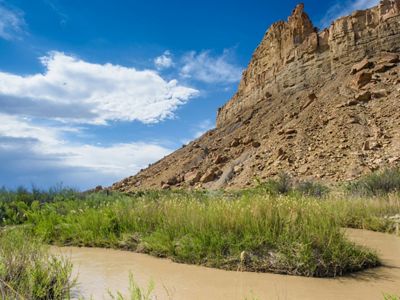
Yet by almost any measure, this life-giving system is in dire jeopardy. Dramatic population growth is fueling water demand at the same time that climate change is diminishing supply. Rivers throughout the Colorado River Basin are being stretched to a breaking point.
“Betting on increased precipitation to bail us out is a really bad bet,” warns Brad Udall, senior water and climate research scientist at Colorado State University. Udall points to a study published in 2018, which tracked the Colorado River Basin and climate change. Udall's words in a recent interview with Newsweek are ominous: "Results strongly suggest that future Colorado River flows will trend strongly downward as temperatures warm in the 21st century, potentially catastrophically.”
Support Our Work in Utah
You can help us do important conservation work along the Price River and beyond.
Donate NowFinding Common Ground in Water
Hotter, drier conditions—and increasing water demands—are realities that Kevin Cotner sees playing out for the Price, a river he’s known for his entire life. “People are certainly realizing that we need to be more conservative with water. I think the younger generation really gets it.” But that doesn’t mean change always comes easy.
With an impish laugh, Cotner admits he was skeptical when TNC and UDWR first approached him with this project. “For years, it was the ‘enviros’ versus agricultural producers and that feeling is still here in some circles. Frankly, I’ve been a little surprised at how easy it has been to deal with TNC. We’ve been able to negotiate issues and come to agreements.”
Cotner hopes more people will see the importance of collaboration, and the need to view each other as allies instead of opponents. “People need to understand that without agriculture, you can’t go to your local Kroger’s and Walmart and expect to find the shelves stocked.” Farmers play an integral role in finding solutions,” he adds. “This is a great example of how we can work together to ensure there’s enough water for food and nature.”
Bellagamba agrees, and she points out that their partnership on the Price could serve as a model and a steppingstone. “The trust we’re building around this project gives us a foundation on which we hope to test other water saving strategies like water banking and implementing the Drought Contingency Plans recently passed by Congress.”
Quote
My son is working my farm today. I hope he has the opportunity to raise his family here and to share the experience I had and learn a true work ethic. For these farms in eastern Utah, it takes extra work and support.
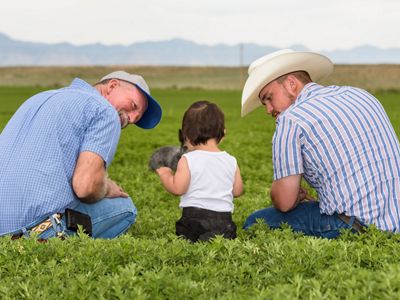
As the midday sun touches down on Cotner’s fields, he and Bellagamba stand side by side surveying the crops. With a happy gurgle, Cotner’s young grandson, Jack, toddles past, waist-deep in the rich green alfalfa. Both the farmer and the conservationist smile. “There is a shared optimism in this project that feels distinct,” notes Bellagamba.
Cotner nods. In many ways, the future of the Price River and his family are one and the same. “My son is working my farm today. I hope he has the opportunity to raise his family here and to share the experience I had and learn a true work ethic. For these farms in eastern Utah, it takes extra work and support. But it’s still a good way of life.”


